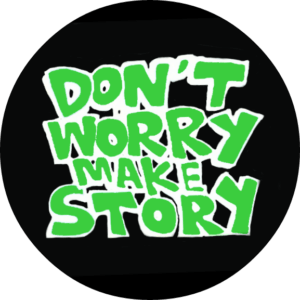
I have always admired storytellers. In the rational social architecture I grew up in, stories were never much more than an illustrations to facts & figures – hard data were the bones that actually counted for making sense. In my hometown Hamburg, the best stories you could hear were the ones from sailors – but how many sailors do you meet as a schoolboy? When I spent time working on the Balkans and then later studying in Ireland, I was surrounded by people for whom stories were the true bones – and facts & figures merely the stuff to illustrate them. „What time does the bus come?“ – „Well dear, I was here yesterday, and when it finally came, the bus driver said…“ – „Great, but what time will the bus be here?“ – „You never wait very long, dear – you know. The other day…“ and so on. Yes, it can get annoying; but story-telling is a great talent and resource.
If we follow the philosopher and father of parallel processing David Gelernter, we all are masters at story-telling, as we move up and down the mental spectrum from “high focus”, where sense-making happens by perception and logic to “low focus”, where it happens by remembering, digesting and story-telling (and eventually, hallucinating and dreaming). It is this move between mental states – the “tides of mind” – that creates the full spectrum of intelligence (a reason to be skeptical about artificial intelligence fully substituting human intelligence, is that we have been mainly concerned with the high focus end of the spectrum. Can an algorithm dream or tell stories? I guess Chat GPT and its friends will let us know soon enough).
Storytelling has gained a good bit of attention in organization development, though maybe not enough. Dialogic Organisation Development is a strand of OD practice that conceptualizes organisations primarily as systems of collective meaning making (Marshak and Bushe 2009). Consequently, narratives and conversational frameworks are the primary point of intervention to transform systems. A narrative can be a trajectory just like a strategy or a structural routine. Path dependence is not just about collective behavior but just as much about collective sense-making. Not surprisingly, the most stubborn trajectory is the core narrative, the story that holds the organizational culture together. If the narrative says “we successfully muddle though”, the organization always can be found muddling and strategic planning is a waste of time (you can hear culture slurping that strategy-breakfast-smoothie). If the narrative features heroic moments, then everyone who wishes to leave a mark on the organization will need to act heroically.
We find the same effect on the individual level and in the broader social arena: the personal narrative has also been coined a “concept of self”. “I’m a bad negotiator”, “I am a victim and not in control”, “I am in control and only I can help myself” are such concepts that build dangerous trajectories and become self-fulfilling prophecies. Therapy and coaching are often about unfreezing and changing such narratives. On the bigger social arena, the narratives are dominant discourse patterns: “We are a superior people”, “Technology solves the problem”, “Individual freedom will bring about collective good” etc. These, too, are powerful trajectories constituting path dependencies. One of the biggest challenges of the “Great Transformation” to a sustainable society is about changing the narrative that everything will be all right if we just keep on growing to the next level.
So how do we change a story? What does it take to unfreeze a path dependence in the realm of discourse, organizational culture or concept of self?
Adding New Layers
Technically, there is no way you can take anything out from a story. A story is a whole – and whatever you cut out will come back twice as strong. This is the mechanics Sigmund Freud first named in relation to suppressed contents and that trauma research has mapped in more detail. So how about adding something to change a story?
There is a great children’s book by Remy Charlip titled “Fortunately – Unfortunately” that my kids loved: It is a story about a boy going to a party and experiencing all kinds of difficulties along the way. The pattern goes like this:
Fortunately, he had plane. Unfortunately, the plane‘s engine failed. Fortunately, he had a parachute. Unfortunately, the parachute didn’t open. Fortunately, there was a haystack underneath him. Unfortunately, there was a pitchfork in the haystack. Fortunately, he missed the pitchfork. Unfortunately, he missed the haystack… and so on.
A story can change its meaning entirely if you add a new ending. It also changes if you add new layers and angles. In the lifecycle of an organisation I often witness how hard it is for people to move on from an old narrative. You can overcome the structural bottlenecks of a pioneering phase and distribute responsibility on more shoulders for the collective phase, and you can build routines and agree on processes to work your way into the formalization phase. But the real change only happens when the story is changed. So, adding a layer here means: acknowledging where we come from and embracing where we are heading. We are pioneering organisation on its way to collective leadership. We have lived with adhocracy long and well, and now it’s time for us to build some formal process.
Working with Creative Tensions
A good story always has more than one core – it lives from creative tension. Equally, a vibrant organization does not just have one pilar of identity but at least two major forces that shape its dynamic. For example, SOCIUS is a bundle of free-spirited entrepreneurs and at the same time a collective of committed partners. These poles seem to contradict one another, and indeed, life between them creates a lot of challenges. However, the magic happens exactly because of those two poles. In his book „Managing the Path of Least Resistance“, Robert Friitz explains how organisations can get stuck in an oscillation between two such forces. As one gains the upper hand, the other gets activated and pulls back, a stabilizing negative feedback loop that effectively prevents a qualitative leap to either side. While oscillation between two competing values can indeed be a barrier to development, we can also look at the two forces as poles of a battery that power creative tension. The moment one pole is abandoned to give way for the other, the magic dies. Subsequently, a way to work with a story is to strengthen the current underdog to revive the creative tension.
A New Concept of Heroes
Most stories involve heroes in one way or another. This is why it is a bit hard to create a compelling story for a post-heroic setting like self-organisation. But heroism does not have to be dead just because we abandon stable power hierarchies. Instead of a post-heroic model we could also imagine a pan-heroic era where everyone is a hero or heroine with whatever special skill or impulse they bring to the table. For me the mental switch between the post-heroic paradigm (no power for no one), to the pan heroic stance (all power to all) was pivotal in the development of our self organisation narrative at SOCIUS.
Another way to switch focus on the hero is to move to the arena of the intangible. Heroes don’t always have to be people. In the mid 90s while hitchhiking through France I rode some days with a Spiral Tribe convoy. The Spiral Tribe was (and in parts still is) a legendary Freetekno Soundsystem that emerged from the London squat scene. After some serious trouble with the British authorities they exiled to continental Europe to drive around in sub collectives with Mad Max‘ish kind of trucks that were homes and party bases at the same time. Getting chased up from parking lots by police in the morning, driving country roads during the day, dumpster diving at dawn, and finally setting up for a pop up Rave at the Atlantic beaches was the daily routine. What fascinated me most about the group was their storytelling culture. There were lots of stories. The lifestyle was rough and frequently people just dropped out or even died on the road while others joined in. But it seemed like people did not really matter that much – heroes of the stories were the trucks. They all had names and personalities, it felt like they were gods and goddesses. You would not ask „How are Tom and Joyce doing?“ but rather „Where is Red Corax riding right now, what shape is he in and what company is he with?“
Ideas, projects and organisations can take on this heroic quality as a focus of a strong narrative. To bring a storytelling culture from a person centered to a collective or idea based quality we need to identify the containers in which purpose is packaged. If those containers can be personified, can breathe personality and life, they may become the heroes of our future stories.
Inviting new Generative Images
A powerful concept proposed by Dialogic OD is the „generative image“. Narratives contain frames that shape our understanding and sensemaking. Generative images are new metaphors that have the potential to change those cognitive frames. “A generative image is one or more words, pictures, or other symbols that provide new ways of thinking about social and organizational reality. They, in effect, allow people to imagine alternative decisions and actions that could not be imagined before the generative image surfaced” (Marshak and Bushe 2016). Generative Images can be invited by soliciting resonance and new perspectives from outsiders or by exploring new sensemaking lenses with creative techniques. A nice and simple dialogic exercise goes like this: I focus on a dilemma, polarity or paradox I experience (e.g. in our organization) and tell the story of a moment where this dilemma became visible. You listen to my story and reflect on the images and metaphors you heard framing my story. You come up with an alternative framing and offer me a generative image to inspire it. I try it out this new image and reflect on the change this effects in my story and my situation.
No, changing the story is not an easy route to take and it requires you to go deep into woodwork. It is a slow but powerful way of transformation.

